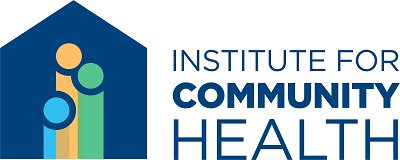I have been at ICH since 2012 and I am currently the Assistant Director of Research. My responsibilities include advising and directing the research portfolio at ICH. I also serve as a team lead on many evaluation components. Because I am a physician, I have an advisory role on health system work which means I also help co-lead ICH’s health system focus area with Ranjani Paradise.
I am also a primary care physician for adults at one of the community health centers in East Cambridge. I serve in two administrative capacities at Cambridge Health Alliance. One is provider lead for provider engagement. This is a role in which I co-chair the Provider Engagement Steering Committee, an interdisciplinary group that is tasked with advising the organization on how to improve provider engagement. I also am the provider lead for social determinants of health. I help develop a strategy and process around systematically screening for and appropriately following up on social determinants of health.
What is your educational background?
I went to Swarthmore College for undergrad. Interestingly I was a bio major with a concentration in public policy, which I think actually has turned out to serve me well. I am more closely aligned with that then I had anticipated.
Then I went to medical school at New York University and then I did my internal medicine internship and residency at Boston Medical Center. My general internal medicine fellowship, which is essentially a research fellowship, was at Harvard Medical School and that was what brought me to Cambridge Health Alliance. CHA was my clinical site and so through the general internal fellowship, I got my masters in public health through the Harvard School of Public Health.
What was your career path before coming to ICH?
After college, I spent some time as a research coordinator at Montefiore Medical Center in the Bronx. There I really wanted to expose myself to physicians that were doing public health work and to see if that was a path I wanted to take. I found that I was really excited by the possibility of being involved in a really meaningful way in individual patient’s lives but also thinking about health policy and how we deliver care. I spent a couple of years there before I went to medical school.
What made you decide to come to ICH?
I was really excited by the concept of a group that was dedicated to helping people improve health in a meaningful way. I have always found data to be really powerful and walked out of my general internal medicine fellowship with research training but really wanted to apply that training with people in a meaningful way to help them understand how to deliver care or programs better.
What has kept me at ICH is the incredible talent and passion within the organization. I feel blessed to be in a position where I derive joy from working with our partners
What are some projects that you are working on right now?
Community Catalyst: Community Catalyst is a national non-profit health care advocacy organization. They have an initiative called the Center for Consumer Engagement in Health Innovation that helps consumers and families, particularly vulnerable populations, have a voice in the healthcare delivery system. The Center runs a grant program called Consumer Voices for Innovation, which provides funding and technical assistance to state consumer health advocacy organizations to build consumer engagement in health system transformation. We are evaluating Consumer Voices for Innovation, which spans multiple states and organizations. It is really fun to think about how to do cross state evaluation of a program that aims to get consumers engaged in advocacy.
California Healthcare Foundation: The goal of this project is to understand to what degree are immigrants contributing and utilizing private health insurance dollars. This is a follow up to some papers that I had written demonstrating that immigrants subsidize Medicare and so now we are investigating if immigrants contribute more to private health insurance than they expend. We are using national data sets as well as data specific to California.
Click here to read more on Leah's paper about how immigrant are subsidizing Medicare.
McManus: This is a grant we got from a small foundation to leverage electronic health record data to understand a little more of the relationship between opioid prescribing and the development of opioid abuse disorder. We are looking within CHA data among patients who have ever been prescribed opioid in our system to see how many developed opioid use disorders, how long it took, and what are clinical predictors of that. The goal is to help guide our understanding of how to prevent opioid use disorders.
What are you most excited about for the future of ICH?
I am really excited for ICH to continue to grow and really take on some of the challenges in healthcare happening right now. I think there are really great opportunities to lend our expertise and our understanding of health systems to help community based organizations and health systems to build capacity for improvement and sustainable community health.
What are your hobbies or things you like to do for fun?
My biggest hobby right now is hanging out with my 3 and 6 year boys. They are delightful but also challenging in every way.
What are your plans for the holidays?
We always go to D.C to spend time with my mom, sister, and niece. We are Jewish but love celebrating Christmas. Then for New Year's Eve, I will be heading over to Cape Cod with some family friends. Our kids love running around outside there- especially at night with glow sticks on the beach!













